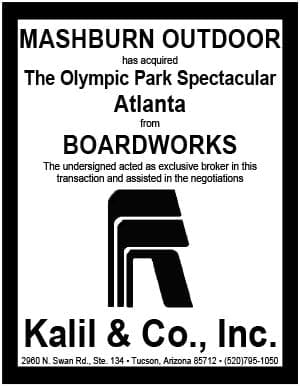
Reader Sharrod Delia of Delia Outdoor Advertising asked Insider for an update on the state of the art for solar powered billboards. To get an update Insider interviewed Kevin Conlin, a consultant who specializes in solar powered billboards.
Kevin, what parts of the country have the best sun for solar billboards?
The most economical systems are in the sunniest parts of the country, particularly the southwest, HOWEVER, they can be economical in almost every part of the country.
I’ve installed economical systems from Oregon to Connecticut.
The exceptions are the Pacific Northwest, the Great Lakes and parts of the northeast. In these locations, it’s the heavy cloud cover in winter that eventually runs the batteries down, even with 10-12 days reserve.

What are key solar billboard components.
Obviously the solar modules are the key, and largest component, followed by the deep cycle batteries and controls.
But the single most important component is the light. Without good lights, everything else is a waste of time and money.
What is a ballpark estimate of costs?
For a 14’ x 48’ bulletin, 2 sided, in a rural area, the solar system is probably in the $10 – 15K range, depending on the location, number of batteries needed, and control options, such as a SmartLink.
Keep in mind these systems still qualify for the 30% federal tax credit, including the lights, so you’re looking at about $10-12K including the lights and installation.
Will utilities rebate any of the cost?
Only for grid tied systems, such as the ones deployed by Lamar. Lamar’s systems don’t use batteries, and feed solar power back into the grid during the day. Utilities love that model.
All of the systems I install are in remote areas where utility power is unavailable, so by default, no.

What mistakes do companies make when installing solar.
The most common mistakes are in this order:
- Purchasing a “one size fits all” system, usually offered at an attractive low price. The reality is, in solar, there is no such system. Every system design depends on a variety of factors, and a good designer takes these into consideration
- Buying substandard, non-billboard lights. Yeah, great price, great promises, but your customer hates them, and soon you will too.
- Too little battery. I like to see at least 7 days, even in areas like Nevada and Arizona. This assures a reliable system, and optimum battery life. In cloudier areas, 10-12 days is not unusual. As a solar designer with over 30 years’ experience, I can tell you a healthy battery reserve is required for a reliable system. Nobody likes those irate customer calls in the middle of winter, wanting to know why his sign isn’t lit..
- Believing the low-cost promises. Trust me, you get what you pay for, and often, a lot less.
A $7,000 solar system that doesn’t work, costs a lot more than a $12,000 one that does.
Have a topic you’d like Insider to write about. Let Insider know using the form below.
[wpforms id=”8663″]
Paid Advertisement

















